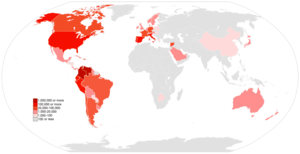Venezuelan Americans
   | |
| Total population | |
|---|---|
|
418,366 (2017 American Community Survey)[1] 0.13% of the U.S. population (2017)[1] | |
| Regions with significant populations | |
| Languages | |
| Religion | |
| Related ethnic groups | |
Venezuelan Americans (Spanish: venezolano-americanos or estadounidenses de origen venezolano) are Americans who trace their heritage, or part of their heritage, to the nation of Venezuela. The word may refer to someone born in the US of Venezuelan descent or to someone who has emigrated to the US from Venezuela.
Venezuelan Americans are one of 20 Latin American groups in the United States. While other US citizens or residents with national origins in any of the Hispanic American countries may be closely related to Spaniards in language and culture, Venezuelan Americans reflect their diversified culture. This includes influences from Spanish, Portuguese, Italians, Germans, and the French, along with influences from African and indigenous Amerindian elements.
Venezuelan Spanish is the group's spoken form of the Spanish language.
In the United States, Venezuelans are on top of the list of nationalities requesting asylum. [2]
History
Until the 20th century, there was no clear record of the number of Venezuelans who emigrated to the United States. During the eighteenth and nineteenth century, there were many European migrants who went originally to Venezuela, but later moved to the United States with their children and grandchildren who were born and/or grew up in Venezuela speaking Spanish. From 1910 to 1930, it is estimated that over 4,000 South Americans each year migrated to the United States. However, there are not many specific figures that indicate the number of Venezuelans among the 4,000.[3]
Many Venezuelans settled in the United States with hopes of receiving a better education, only to remain there following graduation. They are frequently joined by relatives. However, since the 1980s, the reasons for Venezuelan emigration have changed to include hopes of earning a higher salary and due to the economic fluctuations in Venezuela which also promoted an important migration of Venezuelan professionals to the US.[3] In recent years, many Venezuelans opposing the regime of the president Nicolás Maduro are migrating to the US (mostly to Florida, but New York City and Houston are other destinations).
Demographics
The largest concentration of Venezuelans in the United States is in South Florida, especially the suburbs of Doral and Weston. Other main states with Venezuelan American populations are, according to the 2010 census, Texas, New York, California, New Jersey, Georgia and Virginia. Urban areas with a large Venezuelan community include Miami, Houston, New York City, Los Angeles, and Washington, D.C.[3]

States with highest Venezuelan population
The 10 states with the largest Venezuelan population were (Source: Census 2010[4]):
- Florida – 102,116 (0.5% of state population)
- Texas – 20,162 (0.1% of state population)
- New York – 13,910 (0.1% of state population)
- California – 11,100 (less than 0.1% of state population)
- New Jersey – 6,950 (0.1% of state population)
- Georgia – 6,289 (0.1% of state population)
- Virginia – 4,429 (0.1% of state population)
- North Carolina – 4,070 (less than 0.1% of state population)
- Massachusetts – 3,982 (0.1% of state population)
- Maryland – 3,328 (0.1% of state population)
The U.S. state with the smallest Venezuelan population (as of 2010) was South Dakota with 25 Venezuelans (less than 0.1% of state population).
Population distribution by Venezuelan ancestry
Among U.S. communities in 2000 wherein one thousand or more people indicated their ancestry, those where at least 1% of people claimed Venezuelan ancestry were:[5]
- Doral, Florida 8.22%
- Weston, Florida 4.1%
- Fontainebleau, Florida 3.14%
- The Hammocks, Florida 3.14%
- Key Biscayne, Florida 2.36%
- North Bay Village, Florida 2.15%
- Sunny Isles Beach, Florida 1.96%
- Miami Beach, Florida 1.79%
- Virginia Gardens, Florida 1.58%
- Kendale Lakes, Florida 1.54%
- Kendall, Florida 1.47%
- Surfside, Florida 1.41%
- Richmond West, Florida 1.36%
- West Sand Lake, New York 1.34%
- Aventura, Florida 1.31%
- Country Club, Florida 1.26%
- Bal Harbour, Florida 1.21%
- Coral Gables, Florida 1.17%
- Bay Harbor Islands, Florida 1.15%
- Miami Lakes, Florida 1.06%
- Tamiami, Florida 1.06%
- Miami Springs, Florida 1.01%
- Sand Lake, New York 1.01%

By Venezuelan birth
The top 25 U.S. communities with the most residents born in Venezuela are:[6]
.jpg)
- Doral, Florida 11.1%
- North Westside, FL, 5.0%[7]
- Fontainebleau, Florida 4.2%
- Weston, Florida 4.0%
- The Hammocks, Florida 3.3%
- Chambers Estates, Florida 2.8%
- Kendall West, Florida 2.8%
- The Crossings, Florida 2.7%
- Three Lakes, Florida 2.7%
- Key Biscayne, Florida 2.6%
- Sunny Isles Beach, Florida 2.4%
- Kendale Lakes-Lindgren Acres, FL, 2.2%[8]
- Virginia Gardens, Florida 2.1%
- Richmond West, Florida 2.0%
- Golden Beach, Florida 2.0%
- Broadview-Pompano Park, Florida 2.0%
- Ramblewood East, Florida 2.0%
- Kendale Lakes, Florida 1.9%
- Kendall, Florida 1.9%
- St. Regis Park, Kentucky 1.9%
- Coldstream, Kentucky 1.9%
- Country Walk, Florida 1.8%
- Celebration, Florida 1.8%
- Meadow Woods, Florida 1.8%
- Country Club, Florida 1.7%
Ethnic variety
The Venezuelan American population represents Venezuela's ethnic variety. Some 70 percent of Venezuelan immigrants are a mixture of European, Amerindian, and African ancestry. The rest are 21 percent white, 8 percent black and 1 percent is Amerindian. Most Venezuelan Americans are descendants of Spanish (mainly), Italians, Portuguese, Germans, French, and Chinese.[3][9]
Socioeconomics
The Venezuelan American population is highly educated. Its members have bachelor's, graduate, and professional degrees at nearly double (48.5%) the total national percentage (27%), while only 6% of the group's adults did not complete high school, compared to 15.9% of the total national population.[10] Venezuelan Americans are not only highly adapted to the English language and achieve great accomplishments in American education, but also tend to consider the teaching and preservation of the Spanish language a priority. Thus, they teach the language to their children.
Venezuelan Americans work in a variety of professions. However, most of them are inclined to banking and the petroleum industry. Thus, they often have a great expertise in these professions. Venezuelan Americans also work in highlighted positions of television, publishing, and radio industries. Also, many Venezuelan Americans are becoming politicians, working both local politics as in government. In addition, also is growing the number of Venezuelan Americans that work in government service on the federal level. Now, the Venezuelan Americans are involved in all the aspect of the American politics.[3]
Relations with Venezuela
Venezuelan Americans still maintain strong relations with their country of origin, which can easily be seen in business, family, and community life. Venezuelan Americans often report on the social and current events in Venezuela and first-generation immigrants visit there frequently. It is also quite common for Venezuelans to visit their relatives in the United States.[3]
Notable people
See also
References
- 1 2 "US Census Bureau 2017 American Community Survey B03001 1-Year Estimates HISPANIC OR LATINO ORIGIN BY SPECIFIC ORIGIN". Factfinder.census.gov. Retrieved October 11, 2018.
- ↑ The Venezuelan Walkers
- 1 2 3 4 5 6 Drew Walker (2010). "A Countries and Their Cultures: Venezuelan American". Everyculture.com. Retrieved 17 January 2018.
- ↑ "American FactFinder – QT-P10: Hispanic or Latino by Type: 2010". Factfinder2.census.gov. Retrieved 17 January 2018.
- ↑ "Venezuelan ancestry by city – ePodunk". Epodunk.com. Retrieved 2008-12-01.
- ↑ "Top 101 cities with the most residents born in Venezuela (population 500+)". City-data.com. Retrieved 2008-08-01.
- ↑ "North Westside, Florida (FL 33178) profile: population, maps, real estate, averages, homes, statistics, relocation, travel, jobs, hospitals, schools, crime, moving, houses, news, sex offenders". City-data.com. Retrieved 18 January 2018.
- ↑ "Kendale Lakes-Lindgren Acres, Florida (FL 33183) profile: population, maps, real estate, averages, homes, statistics, relocation, travel, jobs, hospitals, schools, crime, moving, houses, news, sex offenders". City-data.com. Retrieved 18 January 2018.
- ↑ "Wayback Machine" (PDF). 20 September 2008.
- ↑ "S0201. Selected Population Profile in the United States; Population Group: Venezuelan". 2006 American Community Survey. United States Census Bureau. Retrieved 2008-06-02.
